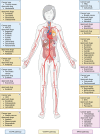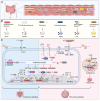Modulation of gut microbiota in targeted cancer therapy: insights on the EGFR/VEGF/KRAS pathways
- PMID: 39593276
- PMCID: PMC11745089
- DOI: 10.20892/j.issn.2095-3941.2024.0320
Modulation of gut microbiota in targeted cancer therapy: insights on the EGFR/VEGF/KRAS pathways
Abstract
The rise in the incidence of cancer globally has led to a heightened interest in targeted therapies as a form of anticancer treatment. Key oncogenic targets, including epidermal growth factor receptor (EGFR), vascular endothelial growth factor (VEGF), and kirsten rat sarcoma viral oncogene homologue (KRAS), have emerged as focal points in the development of targeted agents. Research has investigated the impact of gut microbiota on the efficacy of various anticancer therapies, such as immunotherapy, chemotherapy, and radiotherapy. However, a notable gap exists in the literature regarding the relationship between gut microbiota and targeted agents. This review emphasizes how specific gut microbiota and gut microbiota metabolites, including butyrate, propionate, and ursodeoxycholic acid, interact with oncogenic pathways to modulate anti-tumor effects. Conversely, deoxycholic acid, lipopolysaccharide, and trimethylamine n-oxide may exert pro-tumor effects. Furthermore, modulation of the gut microbiota influences glucose and lipid metabolism, thereby enhancing the response to anti-KRAS agents and addressing diarrhea induced by tyrosine kinase inhibitors. By elucidating the connection between gut microbiota and the EGFR/VEGF/KRAS pathways, this review provides valuable insights for advancing targeted cancer therapy and optimizing treatment outcomes in clinical settings.
Keywords: EGFR; Gut microbiota; KRAS; VEGF; metabolites; targeted therapy; tumorigenesis pathway.
Copyright © 2024 The Authors.
Conflict of interest statement
No potential conflicts of interest are disclosed.
Figures



Similar articles
-
Anti-EGFR and anti-VEGF agents: important targeted therapies of colorectal liver metastases.World J Gastroenterol. 2014 Apr 21;20(15):4263-75. doi: 10.3748/wjg.v20.i15.4263. World J Gastroenterol. 2014. PMID: 24764664 Free PMC article. Review.
-
Personalized medicine in non-small-cell lung cancer: is KRAS a useful marker in selecting patients for epidermal growth factor receptor-targeted therapy?J Clin Oncol. 2010 Nov 1;28(31):4769-77. doi: 10.1200/JCO.2009.27.4365. Epub 2010 Oct 4. J Clin Oncol. 2010. PMID: 20921461 Review.
-
Current Approaches in NSCLC Targeting K-RAS and EGFR.Int J Mol Sci. 2019 Nov 14;20(22):5701. doi: 10.3390/ijms20225701. Int J Mol Sci. 2019. PMID: 31739412 Free PMC article. Review.
-
Combination therapy with KRAS siRNA and EGFR inhibitor AZD8931 suppresses lung cancer cell growth in vitro.J Cell Physiol. 2019 Feb;234(2):1560-1566. doi: 10.1002/jcp.27021. Epub 2018 Aug 21. J Cell Physiol. 2019. PMID: 30132854
-
Molecular predictors of efficacy to anti-EGFR agents in colorectal cancer patients.Curr Cancer Drug Targets. 2010 Feb;10(1):68-79. doi: 10.2174/156800910790980205. Curr Cancer Drug Targets. 2010. PMID: 20088793 Review.
Cited by
-
The Role of the Gut Microbiota in Modulating Signaling Pathways and Oxidative Stress in Glioma Therapies.Cancers (Basel). 2025 Feb 20;17(5):719. doi: 10.3390/cancers17050719. Cancers (Basel). 2025. PMID: 40075568 Free PMC article. Review.
-
The Microbiome Connection: A Common Pathway Linking Cancer and Heart Failure.Biomedicines. 2025 May 25;13(6):1297. doi: 10.3390/biomedicines13061297. Biomedicines. 2025. PMID: 40564016 Free PMC article. Review.
References
-
- Ke X, Shen L. Molecular targeted therapy of cancer: the progress and future prospect. Front Lab Med. 2017;1:69–75.
-
- Wei J, Zheng Z, Hou X, Jia F, Yuan Y, Yuan F, et al. Echinacoside inhibits colorectal cancer metastasis via modulating the gut microbiota and suppressing the PI3K/AKT signaling pathway. J Ethnopharmacol. 2024;318:116866. - PubMed
Publication types
MeSH terms
Substances
Grants and funding
- 81920108027/Major International (Regional) Joint Research Program of the National Natural Science Foundation of China
- Y121/National Outstanding Youth Reserve Talent Training Project, Research Capacity Enhancement Project of Chongqing University Cancer Hospital
- Chongqing Young and Middle-Aged Medical Excellence Team
LinkOut - more resources
Full Text Sources
Medical
Research Materials
Miscellaneous
